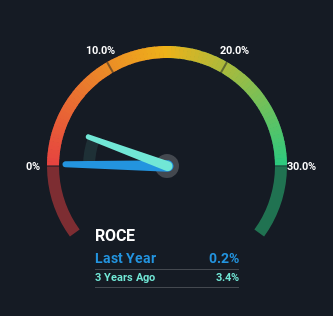- China
- /
- Food and Staples Retail
- /
- SHSE:600827
Shanghai Bailian (Group) (SHSE:600827) Will Be Hoping To Turn Its Returns On Capital Around
When we're researching a company, it's sometimes hard to find the warning signs, but there are some financial metrics that can help spot trouble early. More often than not, we'll see a declining return on capital employed (ROCE) and a declining amount of capital employed. This indicates the company is producing less profit from its investments and its total assets are decreasing. So after we looked into Shanghai Bailian (Group) (SHSE:600827), the trends above didn't look too great.
What Is Return On Capital Employed (ROCE)?
For those who don't know, ROCE is a measure of a company's yearly pre-tax profit (its return), relative to the capital employed in the business. To calculate this metric for Shanghai Bailian (Group), this is the formula:
Return on Capital Employed = Earnings Before Interest and Tax (EBIT) ÷ (Total Assets - Current Liabilities)
0.0016 = CN¥52m ÷ (CN¥56b - CN¥24b) (Based on the trailing twelve months to September 2024).
So, Shanghai Bailian (Group) has an ROCE of 0.2%. Ultimately, that's a low return and it under-performs the Consumer Retailing industry average of 6.0%.
Check out our latest analysis for Shanghai Bailian (Group)

In the above chart we have measured Shanghai Bailian (Group)'s prior ROCE against its prior performance, but the future is arguably more important. If you'd like, you can check out the forecasts from the analysts covering Shanghai Bailian (Group) for free.
What Does the ROCE Trend For Shanghai Bailian (Group) Tell Us?
We are a bit worried about the trend of returns on capital at Shanghai Bailian (Group). Unfortunately the returns on capital have diminished from the 3.4% that they were earning five years ago. On top of that, it's worth noting that the amount of capital employed within the business has remained relatively steady. Companies that exhibit these attributes tend to not be shrinking, but they can be mature and facing pressure on their margins from competition. So because these trends aren't typically conducive to creating a multi-bagger, we wouldn't hold our breath on Shanghai Bailian (Group) becoming one if things continue as they have.
On a separate but related note, it's important to know that Shanghai Bailian (Group) has a current liabilities to total assets ratio of 44%, which we'd consider pretty high. This can bring about some risks because the company is basically operating with a rather large reliance on its suppliers or other sorts of short-term creditors. While it's not necessarily a bad thing, it can be beneficial if this ratio is lower.
Our Take On Shanghai Bailian (Group)'s ROCE
In summary, it's unfortunate that Shanghai Bailian (Group) is generating lower returns from the same amount of capital. Despite the concerning underlying trends, the stock has actually gained 17% over the last five years, so it might be that the investors are expecting the trends to reverse. Regardless, we don't like the trends as they are and if they persist, we think you might find better investments elsewhere.
Since virtually every company faces some risks, it's worth knowing what they are, and we've spotted 2 warning signs for Shanghai Bailian (Group) (of which 1 is potentially serious!) that you should know about.
If you want to search for solid companies with great earnings, check out this free list of companies with good balance sheets and impressive returns on equity.
New: Manage All Your Stock Portfolios in One Place
We've created the ultimate portfolio companion for stock investors, and it's free.
• Connect an unlimited number of Portfolios and see your total in one currency
• Be alerted to new Warning Signs or Risks via email or mobile
• Track the Fair Value of your stocks
Have feedback on this article? Concerned about the content? Get in touch with us directly. Alternatively, email editorial-team (at) simplywallst.com.
This article by Simply Wall St is general in nature. We provide commentary based on historical data and analyst forecasts only using an unbiased methodology and our articles are not intended to be financial advice. It does not constitute a recommendation to buy or sell any stock, and does not take account of your objectives, or your financial situation. We aim to bring you long-term focused analysis driven by fundamental data. Note that our analysis may not factor in the latest price-sensitive company announcements or qualitative material. Simply Wall St has no position in any stocks mentioned.
About SHSE:600827
Shanghai Bailian (Group)
Engages in retail business through department stores, and supermarket and specialty chains in China.
Adequate balance sheet and fair value.
Market Insights
Community Narratives




